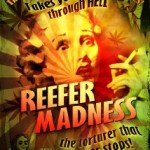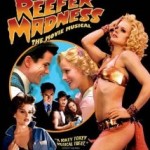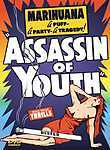In the spirit of April being not only Jazz Appreciation Month, and National Poetry Month, but also National Humor Month – a natural for a month kicked-off by April Fool’s Day – we present the following bit of reportage. Certainly one of the all-time cinematic hilarities is that ultra-cautionary tale “Reefer Madness.” I was recently doing some research at a favorite investigation source – the Institute of Jazz Studies at Rutgers University-Newark. Combing through their DownBeat magazine archives revealed the following piece, from the March 15, 1944 issue of DB (back when the mag was a weekly); reprinted by permission. We could all use a bit of comic relief…

MUSICIANS USED FOR WEED MEDICAL TEST (circa March 15, 1944)
By Frank Stacy
New York–The scientific world is finally paying some heed to the marijuana problem and attacking it from a musician’s viewpoint. According to reliable sources, research doctors attached to government prison-hospitals where drug addicts are confined for cure are currently working on a series of experiments with marijuana, using musicians as guinea pigs. The experiments are designed to find out the effect, if any, the weed has on the quality of a musician’s work and the medics and music-makers are locking themselves up in rooms then blowing their top – but scientifically.
Volunteers for the tests are being taken from among inmates with a musical background. A musical aptitude test is given each subject, both while he is in a normal condition and again while under the influence of marijuana. In this manner the doctors hope to determine why some musicians are attracted to the drug; whether it improves the quality of their playing and whether the whole idea is a bad kick.
Exaggerated Influence

It’s no secret that many musicians have been offenders against have been offenders against the Marijuana Tax Act. The records show this even though the facts have been over-stated to the point where the public believes all musicians and their friends live in a perpetual narcotic whirl.
Marijuana derives its name from a Mexican slang-word, meaning “Mary Jane.” In the United States the drug is known variously as tea, muggles, weed, dry gauge, reefers and hemp. The dried, crushed leaves of the plant are smoked heavily in Oriental countries, including India, Africa [ed’s note: you know, that “country” called Africa], Egypt [ed’s note: …which apparently Egypt is not a part of!], Syria, Greece and Arabia. In many sections of the United States, the plant is grown commercially for its hemp, used in manufacturing rope, hats, and paper. It can be cultivated easily. Due to its rapid spread as a stimulant, the Marijuana Tax Act was passed in 1937 and a curb put on the growing influence of the weed. [Ed’s note: well, they certainly put a cap on that demon weed, didn’t they?]
Problem Studied
Medical men and sociologists regard the drug as a stimulant, having the same physical and mental effects as alcohol. Unlike the pernicious drugs, such as cocaine and heroin, marijuana does not addict its user with an insatiable craving. Case histories of confirmed drug addicts disclose that many found their start with marijuana, which because of its availability and low price is within reach of everyone.
Stories and movies about marijuana users have misinterpreted the drug habit. Rather than the drug creating mental cases for the psychotic ward, the people who use marijuana are already emotionally unstable and turn to the drug as a refuge from life’s problems. [Ed’s note: Is that your excuse?] The basic problem with inveterate users involves a mental rehabilitation of the shattered mind drawn to drugs.

